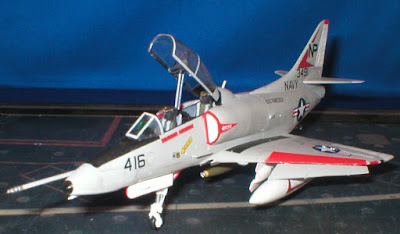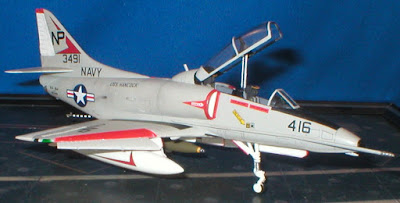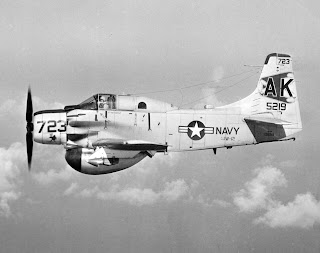Ghostriders in the sky!
Hasegawa 1/72nd scale TA-4F Skyhawk
The Mission: “Two TA-4Fs came on board Hancock in August 1972. Assigned to VA-164, the two-seaters (BuNos 154325 and 153491) had been transferred from the Marine Corps, with the 'Playboy' FAC mission having been cancelled two years before in September 1970.
As now-retired Adm Stan Arthur later wrote, 'Pilots of VA-164 logged some serious combat time in the two-seat A-4. The A-4 squadrons of CVW-21 had been assigned responsibility for developing expertise in unique types of missions, an example being VA-55's specialization in the Iron Hand mission. VA-164 deployed with its aircraft wired for equipment to facilitate the delivery of laser-guided bombs, and worked on developing tactics for delivery and control of those weapons in a high threat environment'.
Several 'Ghostrider' A-4Fs carried a Laser Spot Tracker (LST) in their nose cones, along with a Ferranti gun sight that could show the spot where the laser energy was directed. The problem with this arrangement was that the single-seat 'Foxtrot' pilot had to rely on a FAC, airborne or on the ground, to 'laze' the target. The Navy had developed a hand-held laser, which allowed the aircraft crew to pinpoint the target themselves, but the single-seater pilot could not fly the aircraft and handle the laser simultaneously. Another pair of hands was required, and the TA-4F was just the thing.
Arthur and his unit recruited other crewmen from the CVW-21 squadrons to man the rear seat. Originally, the most likely candidates were Naval Flight Officers (NFOs), usually found in F-4s and A-6s. However, as neither of these aircraft flew with CVW-21, the only NFOs came from the E-lB Tracer det, as well as the occasional pilot looking for a new combat experience. Some of the F-8 and RF-8 pilots tried it, but predictably they did not feel comfortable making an approach to the small flight deck, trusting their safe recovery to another pilot up front.
It would be the only time the two-seat Skyhawk saw combat from a carrier flight deck.
On a particular mission against a bridge near Thanh Hoa (not the well known railway bridge), Arthur had his A-4Fs loaded with an incredible 5000 lbs of ordnance, including two 500-lb bombs on the outboard stations, two 1000-lb bombs on the inner stations and a huge 2000-lb Mk 84 on the centerline, replacing the normal 300-gallon Fuel tank.
The strike plan called for a TA-4F to designate the target for the laser guided bombs from another squadron, and the 'Ghostriders' would drop their ordnance visually. Adm Arthur recalled; 'It was a great bomb load with very little drag, so even with 2000 lbs (a gallon of gas weighs six pounds) of fuel missing, we could fly a fairly normal profile and get back with adequate fuel. Part of the reason we tried this load was our experience with the TA-4Fs. They used the double bubble drop tank configuration, while the "straight" A-4 used a single tank on the centerline. We had starred purring on a 1000-lb Mk 83 so the two-seater could deliver a punch if needed. It was a natural evolution to free up the centerline on a few birds for this strike.
'Of course, it was more complicated than it sounds. One drop tank and two TERs had to be deleted, then fitted back after the strike. There was then the risk that all the connections wouldn't be made right, and the next flight would have hung bombs or the drop tank wouldn't transfer. However, our ordnance gang was top notch, and we had no such problems on the next sorties.'
Pilots manned up to the sound of 'Ghostriders in the Sky', a popular song of the 1950s by Stan Jones relating a cowboy's encounter with spirits on horseback while riding the range. It was just the right sound to send them off as the driving tune piped over the flight deck loudspeaker.
The strike was a success, and Stan Arthur got a direct hit, dropping his huge load in one salvo! Denny Sapp was flying as Iron Hand, and he orbited the striker group as it hit its target. No SAMs came up, and Sapp was Free to film the attack with his 8 mm movie camera.”(1p96-97)
The Airframe: A 2-seat trainer version of the Skyhawk first flew on 6/30/65. Based the A-4E, it was designated the TA-4E. The airframe was stretched 28 itches to add the second cockpit at the expense of 100 gallons of fuel.(2p22) As development progressed, many of the improvements being incorporated into the A-4F were added to the 2-seat version. Those improvements were: nose wheel steering, the more powerful J52-P-8-A engine, wing spoilers, zero-zero ejection seats, and the electronics that were common with A-4F. (3p18) For this reason, the designation was changed to TA-4F. The TA-4F was a true duel-role aircraft. It was a trainer and fully combat capable. TA-4F, BuNo 153491, (this subject of this model) was a war veteran before she went to sea with VA-164. She replaced a TF-9J Cougar in the FastFAC role for the US Marines of HM&S-11 “Playboys” in MAG-11 operating out of DaNang S. Viet Nam until MAG-11 left Viet Nam in 1970.(1p85) Over time, the TA-4Fs didn’t last. Four were modified to EA-4Fs to act as threat aircraft for fleet training. (In my Navy days, we shot down, simulated, a few, and got smoked once in while. Some days you get the bear: some days… well, you know how it goes.) 23 were reworked into OA-4Ms for the Marine Corps. The rest were converted to the straight trainer version: the TA-4J. (3p18-20)
The Model: This model is the Fujimi 1/72 scale TA-4F/J Skyhawk kit. I added plastic card to the main wing slat area to eliminate the small step down. I scratched built a nose gear retraction strut from plastic and steel rods after I broke the kit part trying to remove it from the tree. If the Fujimi Skyhawk kit series has a serious short coming this would be it. Many of the petite parts have heavy molded attachment stubs. No matter how carefully I tried, I broke many detail parts removing them from the trees. That, more than anything, slowed this and A-4F builds. The Mk 83 1000 pound bomb is from the Hasegawa weapons set. I replaced the 20mm gun barrels (broke them, too) with steel tubing and added details to the ejection seat. I very lightly weathered the kit with several pastel chalk grays and highlighted the panel lines with a hard lead pencil.
The Decals: A very Special THANKS! to Joseph Osborn of Fireball Models! He printed the custom decals for this TA-4F of VA-164 based on the color profile found in the book, US NAVY AND MARINE CORP A-4 SKYHAWK UNITS OF THE VIETNAM WAR.(1p70) He was VERY generous with his time and patience! The decal sheet was first rate and was very reasonably priced. Thanks again, Joseph! The tail fin and drop tank chevron decals came from the Fujimi SUPER F SKYHAWK “LAST CRUISE” boxing of the A-4F kit.
There it is! A model of very unique one-time aircraft employment in naval aviation, pictured here next to a stable mate of VA-55. My next Skyhawk will be one from VA-212. That would represent all the attack squadrons of CVW-21 on the USS Hancock.
RJ
Bibliography:
1. US NAVY AND MARINE CORP A-4 SKYHAWK UNITS OF THE VIETNAM WAR, Osprey Combat Aircraft 69, Peter Merssky, Osprey Publishing Limited, Oxford, UK, 2007
2. A-4 Skyhawk Detail 7 Scale Vol 32, Bert Kinzey, Detail & Scale,Inc, Blue Ridge Summit, PA, USA, 1988.
3. A-4 Skyhawk, by Linsay Peacock, Osprey Publishing Limited, London,UK, 1987
4. A-4 Skyhawk in Action, Aircraft No. Eleven $4.95, by Lou Drendel, Squadron / Signal publications, Carrollton, Texas, USA, 1973
5. The SKYHAWK ASSOCIATION at: http://www.skyhawk.org/










Comments
Post a Comment
Please keep comments civil and on topic. Any comment can be remove without warning at the discretion of the moderator.